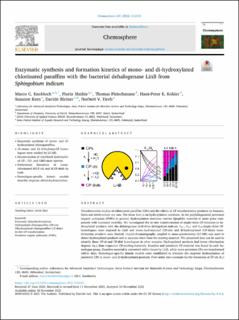Please use this identifier to cite or link to this item:
https://doi.org/10.21256/zhaw-23886Full metadata record
| DC Field | Value | Language |
|---|---|---|
| dc.contributor.author | Knobloch, Marco C. | - |
| dc.contributor.author | Mathis, Flurin | - |
| dc.contributor.author | Fleischmann, Thomas | - |
| dc.contributor.author | Kohler, Hans-Peter E. | - |
| dc.contributor.author | Kern, Susanne | - |
| dc.contributor.author | Bleiner, Davide | - |
| dc.contributor.author | Heeb, Norbert V. | - |
| dc.date.accessioned | 2022-01-12T14:42:18Z | - |
| dc.date.available | 2022-01-12T14:42:18Z | - |
| dc.date.issued | 2021-11-18 | - |
| dc.identifier.issn | 0045-6535 | de_CH |
| dc.identifier.issn | 1879-1298 | de_CH |
| dc.identifier.uri | https://digitalcollection.zhaw.ch/handle/11475/23886 | - |
| dc.description.abstract | Transformation studies of chlorinated paraffins (CPs) and the effects of CP transformation products on humans, biota and environment are rare. The focus here is on hydroxylation reactions. As for polyhalogenated persistent organic pollutants (POPs) in general, hydroxylation reactions convert lipophilic material to more polar compounds with increased mobility. We investigated the in-vitro transformation of single-chain CP-mixtures to hydroxylated products with the dehalogenase LinB from Sphingobium indicum. C11-, C12- and C13-single-chain CP-homologues were exposed to LinB and mono-hydroxylated (CP-ols) and di-hydroxylated (CP-diols) transformation products were formed. Liquid-chromatography coupled to mass-spectrometry (LC-MS) was used to detect hydroxylated products and to separate them from the starting material. The presented data can be used to identify these CP-ol and CP-diol homologues in other samples. Hydroxylated products had lower chlorination degrees (nCl) than respective CP-starting-materials. Reactive and persistent CP-material was found in each homologue group. Reactive material is converted within hours by LinB, while more persistent CPs are transformed within days. Homologue-specific kinetic models were established to simulate the stepwise hydroxylation of persistent CPs to mono- and di-hydroxylated products. First-order rate constants for the formation of CP-ols (k1) and CP-diols (k2) were deduced for different homologues. Lower-chlorinated CP-ols did not accumulate to large extent and were transformed quickly to CP-diols, while higher-chlorinated CP-ols and -diols both accumulated. By enzymatic transformation of single-chain CPs with LinB, we synthesized unique sets of mono- and di-hydroxylated materials, which can be used as analytical standards and as starting materials for metabolic, toxicity and environmental fate studies. | de_CH |
| dc.language.iso | en | de_CH |
| dc.publisher | Elsevier | de_CH |
| dc.relation.ispartof | Chemosphere | de_CH |
| dc.rights | https://creativecommons.org/licenses/by/4.0/ | de_CH |
| dc.subject | Dihydroxylated chloroparaffins (CP-diols) | de_CH |
| dc.subject | Enzymatic dehalohydroxylation | de_CH |
| dc.subject | Hydroxylated chloroparaffins (CP-ols) | de_CH |
| dc.subject | In-vitro CP transformation | de_CH |
| dc.subject | Persistent organic pollutants (POPs) | de_CH |
| dc.subject.ddc | 540: Chemie | de_CH |
| dc.title | Enzymatic synthesis and formation kinetics of mono- and di-hydroxylated chlorinated paraffins with the bacterial dehalogenase LinB from Sphingobium indicum | de_CH |
| dc.type | Beitrag in wissenschaftlicher Zeitschrift | de_CH |
| dcterms.type | Text | de_CH |
| zhaw.departement | Life Sciences und Facility Management | de_CH |
| zhaw.organisationalunit | Institut für Chemie und Biotechnologie (ICBT) | de_CH |
| dc.identifier.doi | 10.1016/j.chemosphere.2021.132939 | de_CH |
| dc.identifier.doi | 10.21256/zhaw-23886 | - |
| dc.identifier.pmid | 34800506 | de_CH |
| zhaw.funding.eu | No | de_CH |
| zhaw.issue | 132939 | de_CH |
| zhaw.originated.zhaw | Yes | de_CH |
| zhaw.publication.status | publishedVersion | de_CH |
| zhaw.volume | 291, Part 2 | de_CH |
| zhaw.publication.review | Peer review (Publikation) | de_CH |
| zhaw.author.additional | No | de_CH |
| zhaw.display.portrait | Yes | de_CH |
| Appears in collections: | Publikationen Life Sciences und Facility Management | |
Files in This Item:
| File | Description | Size | Format | |
|---|---|---|---|---|
| 2021_Knobloch-etal_Mono-dihydroxylated-chlorinated-paraffins_Chemosphere.pdf | 1.47 MB | Adobe PDF |  View/Open |
Show simple item record
Knobloch, M. C., Mathis, F., Fleischmann, T., Kohler, H.-P. E., Kern, S., Bleiner, D., & Heeb, N. V. (2021). Enzymatic synthesis and formation kinetics of mono- and di-hydroxylated chlorinated paraffins with the bacterial dehalogenase LinB from Sphingobium indicum. Chemosphere, 291, Part 2(132939). https://doi.org/10.1016/j.chemosphere.2021.132939
Knobloch, M.C. et al. (2021) ‘Enzymatic synthesis and formation kinetics of mono- and di-hydroxylated chlorinated paraffins with the bacterial dehalogenase LinB from Sphingobium indicum’, Chemosphere, 291, Part 2(132939). Available at: https://doi.org/10.1016/j.chemosphere.2021.132939.
M. C. Knobloch et al., “Enzymatic synthesis and formation kinetics of mono- and di-hydroxylated chlorinated paraffins with the bacterial dehalogenase LinB from Sphingobium indicum,” Chemosphere, vol. 291, Part 2, no. 132939, Nov. 2021, doi: 10.1016/j.chemosphere.2021.132939.
KNOBLOCH, Marco C., Flurin MATHIS, Thomas FLEISCHMANN, Hans-Peter E. KOHLER, Susanne KERN, Davide BLEINER und Norbert V. HEEB, 2021. Enzymatic synthesis and formation kinetics of mono- and di-hydroxylated chlorinated paraffins with the bacterial dehalogenase LinB from Sphingobium indicum. Chemosphere. 18 November 2021. Bd. 291, Part 2, Nr. 132939. DOI 10.1016/j.chemosphere.2021.132939
Knobloch, Marco C., Flurin Mathis, Thomas Fleischmann, Hans-Peter E. Kohler, Susanne Kern, Davide Bleiner, and Norbert V. Heeb. 2021. “Enzymatic Synthesis and Formation Kinetics of Mono- and Di-Hydroxylated Chlorinated Paraffins with the Bacterial Dehalogenase LinB from Sphingobium Indicum.” Chemosphere 291, Part 2 (132939). https://doi.org/10.1016/j.chemosphere.2021.132939.
Knobloch, Marco C., et al. “Enzymatic Synthesis and Formation Kinetics of Mono- and Di-Hydroxylated Chlorinated Paraffins with the Bacterial Dehalogenase LinB from Sphingobium Indicum.” Chemosphere, vol. 291, Part 2, no. 132939, Nov. 2021, https://doi.org/10.1016/j.chemosphere.2021.132939.
Items in DSpace are protected by copyright, with all rights reserved, unless otherwise indicated.